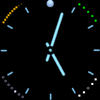You are reading a single comment by @allObjects and its replies.
Click here to read the full conversation.
-
Robust answer, thank you! All the pins fit fine in the prototype area, just wanted to make sure that I didn't accidentally put one in a hole tied to some distant pin! I've seen your images, really clever! But in the pictures above, I just have a handful of (standard) pins and I should only have to solder wire to about six of them. I guess there's only one way to prove it out... ;-)
 yngv126399
yngv126399 @allObjects
@allObjects
@yngv126399,
It all depends on the layout of the pins of the board you want to place onto Espruino.
If the board has two lines of pins falling into the rows of holes of the prototyping area of the Espruino board, it is then just a wiring from the Espruino GPIO pins to those pins.
If the board has a non-fitting pin layout, you need a little adapter board in between for the wiring of the different pin layouts. At that point you may even consider forgetting the prototyping area and go for an adapter board going directly to the GPIO pins of the Espruino board.
What I did - years ago (see http://forum.espruino.com/conversations/127039/#comment5875744, http://forum.espruino.com/conversations/257994/#comment11937364) - was to put machined sockets into the Espruino board holes to have the most flexibility... You can populate just the prototyping area this way and do regular pins on the edge of the board... then you can plug and play using breadboards AND plug-on boards of your choice.
For the (signal) wiring I use enamelled copper with enamel that is heat sensitive and 'burns' away when soldering. I did that for the Pico - with the 1/20 inch pins - and with another Espruino original board - with the pins 'inside' (not on the edge) of the board (A2..A7, B0, B1, B10, B11, and others) and wired them to pins in line with the edge of the board on a separate prototyping board. The prototyping board is a plain thru holes contacted board that I cut to size (for Pico see: http://forum.espruino.com/conversations/327031/#comment14473842). The wiring is on the under side.
In addition to put pin sockets onto the board, I also put plain pins in... the requires a bit filing of the parts of the sockets and pins to fit into the same hole.